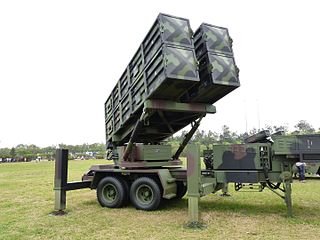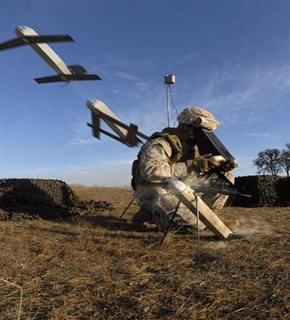Related Research Articles

The AIM-120 Advanced Medium-Range Air-to-Air Missile, or AMRAAM, is an American beyond-visual-range air-to-air missile (BVRAAM) capable of all-weather day-and-night operations. Designed with a 7-inch (180 mm) diameter, and employing active transmit-receive radar guidance instead of semi-active receive-only radar guidance, it has the advantage of being a fire-and-forget weapon when compared to the previous generation Sparrow missiles. When an AMRAAM missile is launched, NATO pilots use the brevity code Fox Three.

The Boeing CIM-10 BOMARC was a supersonic ramjet powered long-range surface-to-air missile (SAM) used during the Cold War for the air defense of North America. In addition to being the first operational long-range SAM and the first operational pulse doppler aviation radar, it was the only SAM deployed by the United States Air Force.

The Tri-Service aircraft designation system is a unified system introduced in 1962 by the United States Department of Defense for designating all U.S. military aircraft. Prior to then, the U.S. armed services used separate nomenclature systems.

Joint Regulation 4120.15E: Designating and Naming Military Aerospace Vehicles is the current system for designating all aircraft, helicopters, rockets, missiles, spacecraft, and other aerial vehicles in military use by the United States Armed Forces.

The Hughes AIM-47 Falcon, originally GAR-9, was a very long-range high-performance air-to-air missile that shared the basic design of the earlier AIM-4 Falcon. It was developed in 1958 along with the new Hughes AN/ASG-18 radar fire-control system intended to arm the Mach 3 XF-108 Rapier interceptor aircraft and, after its cancellation, the YF-12A. It was never used operationally, but was a direct predecessor of the AIM-54 Phoenix.

The Avenger Air Defense System, designated AN/TWQ-1 under the Joint Electronics Type Designation System, is an American self-propelled surface-to-air missile system which provides mobile, short-range air defense protection for ground units against cruise missiles, unmanned aerial vehicles, low-flying fixed-wing aircraft, and helicopters.
The Joint Electronics Type Designation System (JETDS), which was previously known as the Joint Army-Navy Nomenclature System and the Joint Communications-Electronics Nomenclature System, is a method developed by the U.S. War Department during World War II for assigning an unclassified designator to electronic equipment. In 1957, the JETDS was formalized in MIL-STD-196.

The Martin MGM-1 Matador was the first operational surface-to-surface cruise missile designed and built by the United States. It was developed after World War II, drawing upon their wartime experience with creating the Republic-Ford JB-2, a copy of the German V-1. The Matador was similar in concept to the V-1, but it included a radio command that allowed in-flight course corrections. This allowed accuracy to be maintained over greatly extended ranges of just under 1000 km. To allow these ranges, the Matador was powered by a small turbojet engine in place of the V-1's much less efficient pulsejet.

National Chung-Shan Institute of Science and Technology is a Taiwanese state owned corporation, formerly part of the Republic of China Ministry of National Defense's Armaments Bureau, which is active in the development, manufacturing, support, and sustainment of various weapons systems and dual use technologies.

The McDonnell ADM-20 Quail was a subsonic, jet powered, air-launched decoy cruise missile built by McDonnell Aircraft Corporation. The Quail was designed to be launched by the Boeing B-52 Stratofortress strategic bomber and its original United States Air Force designation was GAM-72.
From 1922 until 1962, the United States Navy, the United States Marine Corps and the United States Coast Guard used a system to designate their aircraft that included information about a craft's role and its manufacturer. For a listing of all such designations, see the list of United States Navy aircraft designations (pre-1962).

The GAM-63 RASCAL was a supersonic air-to-surface missile that was developed by the Bell Aircraft Company. The RASCAL was the United States Air Force's first nuclear armed standoff missile. The RASCAL was initially designated the ASM-A-2, then re-designated the B-63 in 1951 and finally re-designated the GAM-63 in 1955. The name RASCAL was the acronym for RAdar SCAnning Link, the missile's guidance system. The RASCAL project was cancelled in September 1958.

The MA-31 was a conversion of the Kh-31 anti-ship missile, developed by the Soviet Union during the 1980s, for use as a target drone by the United States Navy. Although the missile proved successful in this role, political complications resulted in the type being only an interim solution, and only a small number of the missiles were acquired.

The RGM-59 Taurus was an American project, conducted by the United States Navy, that was intended to develop a surface-to-surface missile for use as a fire support weapon during amphibious landings, replacing heavy-caliber naval guns. Developed during the early 1960s, the project was cancelled before any hardware development was undertaken.
The ZBGM-75 Advanced Intercontinental Ballistic Missile, also known as Weapons System 120A (WS-120A), was a program to develop an intercontinental ballistic missile (ICBM), proposed by the United States Air Force in the 1960s as a replacement for the LGM-30 Minuteman as the Air Force's standard ICBM. Funding was not allocated for the program and the project was cancelled in 1967.
The RIM-113 Shipboard Intermediate Range Combat System, or SIRCS, was an advanced surface-to-air missile proposed by the United States Navy in the 1970s. The project failed to be approved for funding and was cancelled in 1979.

Martlet is a lightweight air-to-surface, surface-to-air, and surface-to-surface missile developed by Thales Air Defence for the United Kingdom.

The AeroVironment Switchblade is a miniature loitering munition, designed by AeroVironment and used by several branches of the United States military. Small enough to fit in a backpack, the Switchblade launches from a tube, flies to the target area, and crashes into its target while detonating its explosive warhead. The name switchblade comes from the way the spring-loaded wings are folded up inside a tube and flip out once released.
A loitering munition is a weapon system category in which the munition loiters around the target area for some time and attacks only once a target is located. Loitering munitions enable faster reaction times against concealed or hidden targets that emerge for short periods without placing high-value platforms close to the target area, and also allow more selective targeting as the attack can easily be aborted.
References
- 1 2 "Current Designations of U.S. Unmanned Military Aerospace Vehicles".
- ↑ "Pre-1963 Designations of U.S. Missiles and Drones".
- ↑ Trapp, Robert E.; Berkeley, William P.; Egerland, Arnold V. (1967). "The Criteria for an Equipment Identification Coding System" (PDF). Air Force Institute of Technology School of Systems and Logistics. p. III-22. Archived from the original (PDF) on 13 April 2022. Retrieved 13 April 2022.
- ↑ "New missile code names reveal wealth of information on them". Air University Library Index to Military Periodicals. Air University Library. 13–15 (4): 689. 1964. Archived from the original on 13 April 2022. Retrieved 13 April 2022.
- ↑ Mindling, George; Bolton, Robert (2008). "U.S. Air Force Tactical Missiles 1949-1969 The Pioneers". Lulu.com. p. 269. Archived from the original on 20 June 2020. Retrieved 21 April 2022.